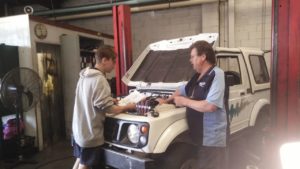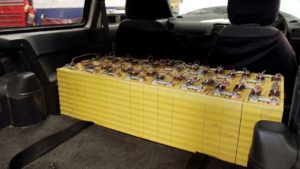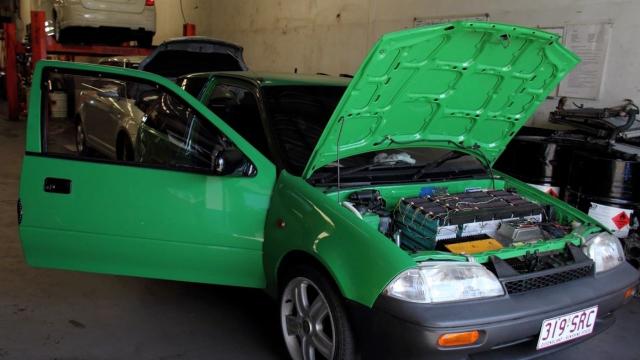The most sustainable thing that we can do for our environment is consume less, so why aren’t electric car conversions more popular?
Over the next few years, we’re bound to see more and more car companies committing to cut-off dates where they’ll be done with fossil fuels. Chrysler announced an end to their fossil fuel vehicles is coming and companies like Mazda and Cadillac have also committed to all-electric futures within the decade.
While not having carbon dioxide spewing out of cars in the future is welcome, changing to electric vehicles doesn’t solve every problem as far as sustainability goes. The production of new electric vehicles requires tonnes of newly sourced materials, particularly for the batteries, electrical components and chassis.
This is exacerbated by the considerably low life that electric cars have, with batteries losing their effectiveness around the 10 to 20-year mark. EVs haven’t been able to beat petrol cars on this front so far.
So, what about converting your car to an electric one? Many of the parts are already present (the chassis, the wheels, the dash and the seats) so there’s a sustainability argument to be made. Well, it’s a little more complicated than simply converting.
Jacques Hickey is the lead electric vehicle technician at Oz DIY Electric Vehicles and he’s been there for about a year now. He manages a small team of technicians who service and upgrade electric vehicles and specialise in converting petrol vehicles into electric cars.
“I just see the biggest issue as training, actually,” Hickey told Gizmodo Australia.
“This applies not just to EV conversions but EVs as a whole. We’re looking at electric vehicles coming in now, getting them serviced, getting them maintained– it just doesn’t happen.
“Half our business at the moment is servicing EVs that dealerships won’t touch, because they don’t have trained staff.”

Oz DIY Electric vehicles have a few different areas of business, though the company considers itself to be “The Car Conversion Experts”. The first avenue of business for the company is providing electric vehicle kits, giving customers the power to turn their cars into EVs themselves.
The second is doing those conversions for customers out of workshops in Townsville and Brisbane. Hickey said it takes upwards of 100 man-hours to do this.
Then, the third is maintaining existing EVs, like the Nissan Leaf and the Mitsubishi I-MiEV.
“The hardest part of the whole thing is packaging and bracketry. 90 per cent of what we’re doing with a conversion is building components, brackets, parts that mount everything up. Finding a space for that, packaging it all neatly – that’s probably about 70 per cent of our working hours spent doing that,” Hickey explained.
“The remaining 20 per cent is in doing wiring and then 10 per cent is in programming and debugging, testing and all that sort of stuff. The [other] hardest part is maybe sourcing the parts.”
As you can expect, the electric car conversion business has been hit hard by global shortages, with Hickey saying that “chip shortage” is a phrase heard often around the office.
Despite that, Hickey says that his business has been booming over the pandemic, with more business than his company (and other EV companies) can keep up with.
And yet, with business supposedly taking off and supply shortages in mind, what’s keeping the EV conversion business from becoming more mainstream? Well, in short, it’s expensive. Too expensive.
I asked Hickey what it would cost to convert a car to a similar range of the Tesla Model 3, the cheapest Tesla in Australia (and one of the cheapest electric vehicles in the country), which costs $59,990.
He told me, for a similar experience, it would cost $40,000 for a pack of essential parts, $10,000 for the motor and $10,000 for accessories – and that’s before either paying for installation (which costs upwards of $10,000) or installing it yourself.
“I’m not talking down on them, I love them, I’d do it in a heartbeat, but if you just wanna have a run-about A to B, for $45,000 you can get yourself an MG in Australia that’ll do that,” he said.

While Hickey agrees that it’s far more sustainable to convert a vehicle to electric than to buy an all-new electric vehicle (he wagered it was somewhere between 30 and 40 per cent more sustainable, more so if using second-hand cells and components), it just doesn’t make sense economically right now.
I asked Hickey about what could help the electric car conversion industry, between government policy ideas and subsidy plans, to make it more economically viable. He said the biggest problem is actually more raw: it comes down to the issue of education and training.
He sees a lot of potential for the EV conversion industry in training more people to do the job and that creating government incentives similar to those available for an electrical trade could be a worthwhile area to explore.
“If I don’t have to charge someone $200 an hour in labour to have a highly specialised, trained technician on, there goes a quarter of the cost,” he said.
“If people are trained to do it, then, you know, that’ll bring quantity up, bring supply parts and costs down, and then, you know, have the simple supply and demand.”
For the moment, Hickey says that it’s most viable to do an electric car conversion on a classic car (where the cost of the conversion is actually lower than buying legacy parts), a special use vehicle (like for mining sites or farming) or for motorsport.
Other than that, he encouraged buying an older-model second-hand EV and upgrading it with modern tech, to give it a second lease on life and consume less overall.
EVs are here to stay, but we could be doing more to support the entire industry.
